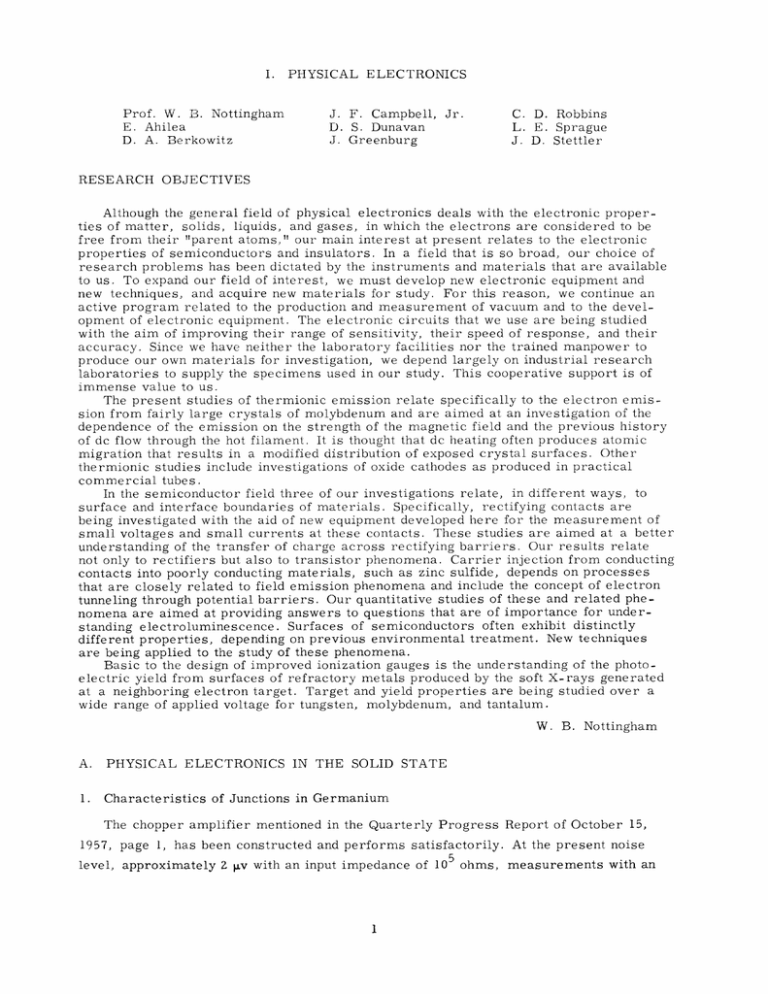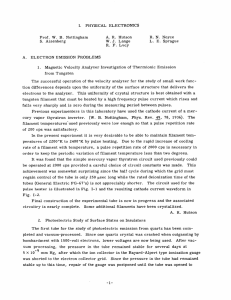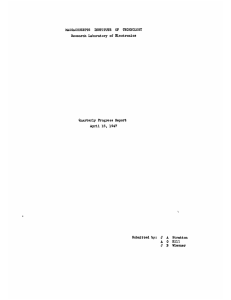I. PHYSICAL ELECTRONICS Prof. W. B. Nottingham
advertisement

I. Prof. W. B. Nottingham E. Ahilea D. A. Berkowitz PHYSICAL ELECTRONICS J. F. Campbell, D. S. Dunavan J. Greenburg Jr. C. D. Robbins L. E. Sprague J. D. Stettler RESEARCH OBJECTIVES Although the general field of physical electronics deals with the electronic properties of matter, solids, liquids, and gases, in which the electrons are considered to be free from their "parent atoms," our main interest at present relates to the electronic properties of semiconductors and insulators. In a field that is so broad, our choice of research problems has been dictated by the instruments and materials that are available to us. To expand our field of interest, we must develop new electronic equipment and new techniques, and acquire new materials for study. For this reason, we continue an active program related to the production and measurement of vacuum and to the development of electronic equipment. The electronic circuits that we use are being studied with the aim of improving their range of sensitivity, their speed of response, and their accuracy. Since we have neither the laboratory facilities nor the trained manpower to produce our own materials for investigation, we depend largely on industrial research laboratories to supply the specimens used in our study. This cooperative support is of immense value to us. The present studies of thermionic emission relate specifically to the electron emission from fairly large crystals of molybdenum and are aimed at an investigation of the dependence of the emission on the strength of the magnetic field and the previous history of dc flow through the hot filament. It is thought that dc heating often produces atomic migration that results in a modified distribution of exposed crystal surfaces. Other thermionic studies include investigations of oxide cathodes as produced in practical commercial tubes. In the semiconductor field three of our investigations relate, in different ways, to surface and interface boundaries of materials. Specifically, rectifying contacts are being investigated with the aid of new equipment developed here for the measurement of small voltages and small currents at these contacts. These studies are aimed at a better understanding of the transfer of charge across rectifying barriers. Our results relate not only to rectifiers but also to transistor phenomena. Carrier injection from conducting contacts into poorly conducting materials, such as zinc sulfide, depends on processes that are closely related to field emission phenomena and include the concept of electron tunneling through potential barriers. Our quantitative studies of these and related phenomena are aimed at providing answers to questions that are of importance for understanding electroluminescence. Surfaces of semiconductors often exhibit distinctly different properties, depending on previous environmental treatment. New techniques are being applied to the study of these phenomena. Basic to the design of improved ionization gauges is the understanding of the photoelectric yield from surfaces of refractory metals produced by the soft X-rays generated at a neighboring electron target. Target and yield properties are being studied over a wide range of applied voltage for tungsten, molybdenum, and tantalum. W. A. PHYSICAL ELECTRONICS IN THE SOLID STATE I. Characteristics of Junctions in Germanium B. Nottingham The chopper amplifier mentioned in the Quarterly Progress Report of October 15, 1957, page 1, has been constructed and performs satisfactorily. At the present noise level, approximately 2 iv with an input impedance of 105 ohms, measurements with an (I. PHYSICAL ELECTRONICS) accuracy of approximately 10 [v are entirely practical on samples with resistances of 105 to 10 ohms. The increased sensitivity of the new detector makes noise pickup in the measuring equipment extremely important. A new potentiometer with better shielding and of smaller physical size is being constructed to replace the Leeds and Northrup Type K2 potentiometer that was previously used. A sample holder that has better shielding and allows wider temperature variation is also being designed. J. F. Campbell, Jr. 2. Surface States on Semiconductors In this experiment we wish to correlate changes in the density of surface traps in germanium, caused by changes in ambients, with changes that occur in the contact potential of the germanium sample. The contact-potential changes are measured by determining the shift of the plot of a current of electrons, emitted by a tungsten ribbon and retarded by the germanium. In preliminary experiments the sample was cooled to dry-ice temperature and a retardation plot was taken as an increasingly negative voltage was being applied to the sample. A small amount of oxygen was then introduced into the tube while a Tesla coil was sparking nearby in order to convert some of the oxygen into ozone. The gas was later pumped down to a pressure of approximately 10-7 mm Hg. When a second retardation plot was taken, we found that the plot had shifted toward positive, or that the workfunction of the sample increased, approximately 0. 5 volt. We believe that the workfunction of the tungsten ribbon was restored to its original value and that the gas that had been introduced was flashed away by heating the ribbon, since there was no change in the total emission current from the ribbon. E. Ahilea 3. Electroluminescence The work on electroluminescence mentioned in the Quarterly Progress Report of October 15, 1957, page 1, has resolved into a detailed study of the conduction processes in single, needle-shaped crystals of zinc sulfide. The crystal lengths vary from 0. 1 cm to 1 cm; the thicknesses vary from 0. 01 cm to 0. 02 cm. A crystal is held by electrodes at both ends. The voltage is supplied by a trapezoidal generator. The initial linear voltage rise, from 0 volt to the maximum applied voltage of 300 volts, takes place in 90 seconds. The maximum voltage can be maintained indefinitely. The current is meas- ured with a vibrating-reed electrometer. Measurements in which painted platinum electrodes are used indicate steady-state currents in the range of 10 with larger voltages. 15 amp, which increase (I. PHYSICAL ELECTRONICS) In an effort to obtain better electrodes, a crystal holder and an evaporation shield are being built for evaporating metallic contacts onto the crystal under high-vacuum conditions. D. A. Berkowitz B. ELECTRON EMISSION PROBLEMS 1. Effect of a Magnetic Field and of a Unidirectional Heating Current on Thermionic Emission from Molybdenum This experiment was designed to investigate two effects: that of an external magnetic field on the thermionic-emission current from a clean metal surface, and that of sus- tained dc heating of the metal on its emitting properties, by virtue of the changes in surface structure induced by such heating. The background of the magnetic field problem was given in the Quarterly Progress Report of January 15, 1957, page 2, together with a description of the tube design. The dc heating effect was discussed in the Quarterly Progress Report of July 15, 1957, page 1. Recent work was devoted to construction of the circuitry, which is now complete. This includes a collector circuit, designed to measure very small currents to the 4 anodes of the tube, individually or in any combination; ac and dc heating sources for the filament; a circuit associated with an internal pyrometer filament, by means of which the temperature of the main filament can be monitored in terms of current and voltage measurements; and the circuit for energizing the magnet. Tentative measurements, taken with a temporary circuit, show that the measured in fact, vary appreciably with applied magnetic field. plate current does, However, I prefer to reserve further comment until more thorough quantitative data have been taken with the present circuit. J. C. EXPERIMENTAL 1. Low-Pressure Measurements Greenburg TECHNIQUES The M. I. T. modification of the Bayard-Alpert ionization gauge has been described in detail (1). Calibration data for this gauge show that the highest pressure for satisfac- tory use is 2 X 10 - 3 mm. Although other gauge types, including the McLeod gauge, serve well for the "static" measurement of pressure in the range up to 1 mm, a fast- acting gauge of very small dimensions would aid the solution of vacuum problems that demand measurement in a small fraction of a second. Two lines of investigation are being followed. One is the design and construction of an ionization gauge suitable for this pressure range. The first design included a platinum filament as the electron (I. PHYSICAL ELECTRONICS) source. It proved unsatisfactory because the emission of positive ions from the filament and the evaporation of atoms from it are excessive at filament temperatures that are suitable for the production of the required electron emission. ments will be tried if they can be obtained. Irridium fila- The second approach depends upon the use of a standard hot wire and thermocouple unit, American Thermo-Electric Company Type W-54, combined with a new design of electronic circuit. cate its serviceability over a thousandfold Preliminary tests indi- range in pressure from approximately 3 mm to 3 microns. W. B. Nottingham References Vacuum Symposium Transactions, 1. W. B. Nottingham, 2. Electrometer for Currents down to 10 -12 1954, p. 76. amp Studies on a vacuum-tube electrometer designed by H. Shelton (1) have been started. Values of the passive components have been changed to agree with those that were indicated by theoretical analysis. A frequency-response determination is in progress. Since this meter is designed to work from a very high impedance source, nated by chopped light is being used. a phototube illumi- A determination of linearity is planned. J. D. Stettler References 1. H. Shelton, Thermionic emission from a planar tantalum crystal, Ph. D. Thesis, Department of Physics, M. I. T., May 14, 1956. 3. Photoelectrons Produced by Soft X-rays An investigation was begun to determine the relative magnitude of production of soft X-rays by tungsten, tantalum, and molybdenum when they are bombarded by electrons in the range of 0-600 volts, and the emission of photoelectrons from these metals when they absorb the soft X-rays. A tube incorporating 0. 001-inch tungsten, tantalum, and molybdenum ribbons a cylindrically symmetrical arrangement is being manufactured. These ribbons be heated by passing a current through them so that the effect of changes condition can be studied. The primary electron source is in can in surface a tungsten filament held on the axis of the tube. D. S. Dunavan (I. 4. PHYSICAL ELECTRONICS) Pressure Computation from McLeod Gauge Measurements Pressure measurements with a McLeod gauge depend on an application of Boyle's law for gases. The resulting equation is: a (h'p = VO (1) h o )(dh) In this equation Ah is the difference in the mercury levels in the open and closed This quantity is directly measurable and indicates capillaries. the pressure difference between the gas compressed in the closed capillary and that in the open capillary. The capillaries must be clean and of equal and uniform cross section. The quantity (h' - h 0 ) usually expressed in millimeters, between the mercury surface represents the distance, and the "effective" top of the closed capillary. accurate measurements, Before a McLeod gauge can be used for the location of the effective top of the capillary must be deter- mined experimentally; the details are given below. illary is denoted by a, The area of cross section of a cap- the total volume of gas trapped off by the capillary and the main bulb of the McLeod gauge by V . A consistent system of units is obtained if the area is expressed in square millimeters, the volume in cubic millimeters, and the distance measurements in millimeters. In that case the pressure will be expressed in millimeters of mercury. To determine the effective end of the closed capillary, at some arbitrary and unknown value. gas pressure is introduced The distance h' is measured from an arbitrary fiducial line near the top of the closed capillary. A convenient point is the top external surface of the glass that closes this capillary. As the gas in the closed capillary is compressed, three readings of Ah and the corresponding h' values can be observed. In a similar manner, two or three more readings can be made as the mercury is lowered. This set of five readings can be related by the following equation: h' = h o + PV a ( (2) Ah Equation 2 shows a linear relation between the observable quantities h' and (1/Ah). plot of h' as a function of (/Ah) A should yield a straight line with an intercept at h . Analytical methods, including the least-square determination, may also be used instead of the graphical method. For each arbitrarily chosen pressure, the data should yield the same value of h , within the limits of experimental error. If systematic differences occur, the indications are that the capillary is either dirty or nonuniform. The principle purpose of describing this technique is to call attention to the very simple graphical means of computing pressure from McLeod readings, after the effec- tive location of the top of the capillary has been determined and a millimeter measuring scale has been constructed. The zero value of this scale is set to coincide with the (I. PHYSICAL ELECTRONICS) h -- 100 - 90 80 PRESSURE h (mm Hg) 100 90 80 70 70 10 -2 60 60 8 50 6 50 40 4 40 3 30 30 2 20 - 10 20 8 6 - x 102 2.4 2.43 x 10 4 x 10 3 10 9 8 10 2 9 8 7 10' 6 7 6 8 5 6-- 5 4 -4 4 3 3 3 2 2 -5 10 2 8 -- 6 4 S10 2 x 10-6 Fig. I-1. Pressure calculation chart; between the mercury column capillary; Ah is the distance cury levels in the closed and h is the distance (in millimeters) and the effective top of the closed (in millimeters) between the meropen capillaries. effective top of the capillary. With an unknown pressure of gas in the system, pair of observations that will fit the simplified form of Eq. 1 can be made, a new in which (h' - h o ) has been replaced by h: p z a V h(Ah) (3) The usual use of the McLeod gauge involves setting the mercury columns so that h and (Ah) are exactly equal and the pressure is read from a scale or a curve drawn up for the particular gauge for which (a/V ) is known. A new method of analysis depends on the nomographic chart shown in Fig. I-1, applied to a gauge which has a value of 2. 43 X 106 for the (a/V ) ratio. The evaluation of the pressure with the help of this chart greatly facilitates the taking of accurate (I. readings because it is unnecessary to adjust h to equal Ah. PHYSICAL ELECTRONICS) The reason that this proce- dure is difficult and time-consuming is that the mercury levels seldom stop at their true locations when the experimenter ceases raising or lowering the mercury column. It is always necessary to tap the glass vigorously to make the mercury levels in the closed and open capillaries take their correct locations. Under these circumstances, it is extremely difficult to adjust the level so that the open column exactly coincides with the effective top of the closed capillary. As an example of the use of this chart, the value of h might be observed as 6. 5 mm and Ah as 9 mm. The observer places a straight edge across the chart with the intersection at each outside line coinciding with these values, and reads the pressure on the middle scale directly as 1. 4 X 10-4 mm. The dashed line illustrates this example. The method used for the construction of a chart of this kind is very simple. The three vertical lines are drawn parallel to each other with equal spacing. The two outside lines have two decades of a logarithmic scale reproduced from suitably chosen graph paper. An index line is drawn between the "10-mm" points. A second sheet of paper, preferably transparent, scale. has a single line drawn on it and a four-cycle logarithmic Two cycles on this scale correspond precisely to one cycle of the first scales. The working chart is produced by setting the "10-10" index line at the known value of the ratio (a/V o ). Even though the length of the capillaries may be 150 or ZOO mm, the chart may be used in the form that is shown over the entire operational range of the gauge simply by shifting the exponent that is used in the "read-out" column. For example, h is 160, then the pressure will be 3. 6 X 10 - if Ah is 90 and . This combination is illustrated by the dotted line in Fig. I-1. W. B. Nottingham






